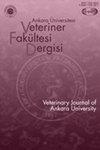Effects of Short-Term Transportation and Lairage Time on Meat Quality, CAST, CAPN1, CAPN3, HSPA1A Gene Expression Levels and Myofibrillary Structure of M. longissimus dorsi of Kıvırcık Breed Sheep
IF 0.9
4区 农林科学
Q3 VETERINARY SCIENCES
引用次数: 0
Abstract
The objective of this study was to examine the effect of short term transportation and lairage time on meat quality, myofibrillary structure and calpastatin (CAST), µ-calpain (CAPN1), calpain 3 (CAPN3) and heat shock protein 70 (HSPA1A) expression levels of longissimus dorsi of Kıvırcık breed sheep (n=40). Meat quality was evaluated by muscle glycogen amounts, pH, temperature, cooking loss, water holding capacity, shear force, instrumental color, sarcomere length and organoleptic properties. Cellular changes in the muscle during the ageing process was scanned by electron microscopy and CAST, CAPN1, CAPN3, HSPA1A expression levels were measured to reveal the association on meat tenderness. As a result, positive effect of long lairage time groups was observed in the pH, glycogen, SF values and organoleptic evaluation. CAST, CAPN1, CAPN3 expression showed no difference, however, HSPA1A showed significant difference in aging process. In conclusion, genotypic differences, their effect on gene expression and protein level on meat quality should be further investigated.短期运输和饲养时间对Kıvırcık品种背最长支原肌肉品质、CAST、CAPN1、CAPN3、HSPA1A基因表达水平和肌纤维结构的影响
本研究旨在研究短期运输和贮藏时间对Kıvırcık品种绵羊背最长肌肉质、肌原纤维结构和钙pastatin (CAST)、µ-calpain (CAPN1)、calpain 3 (CAPN3)和热休克蛋白70 (HSPA1A)表达水平的影响(n=40)。通过肌糖原量、pH值、温度、蒸煮损失、保水能力、剪切力、仪器颜色、肌节长度和感官特性来评价肉质。通过电镜扫描衰老过程中肌肉细胞的变化,并检测CAST、CAPN1、CAPN3、HSPA1A表达水平,以揭示其与肉嫩度的关系。结果显示,长饲养时间组在pH、糖原、SF值和感官评价方面均有积极作用。CAST、CAPN1、CAPN3的表达差异无统计学意义,而HSPA1A在衰老过程中差异有统计学意义。综上所述,基因型差异及其对肉品质的基因表达和蛋白质水平的影响有待进一步研究。
本文章由计算机程序翻译,如有差异,请以英文原文为准。
求助全文
约1分钟内获得全文
求助全文
来源期刊
CiteScore
1.50
自引率
0.00%
发文量
44
审稿时长
6-12 weeks
期刊介绍:
Ankara Üniversitesi Veteriner Fakültesi Dergisi is one of the journals’ of Ankara University, which is the first well-established university in the Republic of Turkey. Research articles, short communications, case reports, letter to editor and invited review articles are published on all aspects of veterinary medicine and animal science. The journal is published on a quarterly since 1954 and indexing in Science Citation Index-Expanded (SCI-Exp) since April 2007.

 求助内容:
求助内容: 应助结果提醒方式:
应助结果提醒方式:


